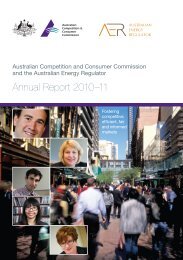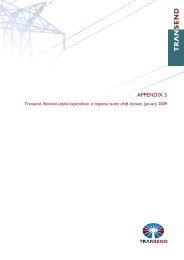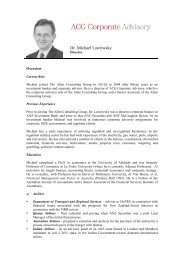Internal consistency of risk free rate and MRP in the CAPM
Internal consistency of risk free rate and MRP in the CAPM
Internal consistency of risk free rate and MRP in the CAPM
Create successful ePaper yourself
Turn your PDF publications into a flip-book with our unique Google optimized e-Paper software.
7. How should <strong>the</strong> cost <strong>of</strong> equity be estimated<br />
149. This section considers four broad brush approaches/methodologies for arriv<strong>in</strong>g at an<br />
estimate <strong>of</strong> <strong>the</strong> cost <strong>of</strong> equity <strong>and</strong> assesses <strong>the</strong> <strong>consistency</strong> <strong>of</strong> <strong>the</strong>se with <strong>the</strong> National<br />
Gas Rules <strong>and</strong> National Gas Law. In particular:<br />
� Rule 87(1) which states that <strong>the</strong> <strong>rate</strong> <strong>of</strong> return on capital is to be commensu<strong>rate</strong><br />
with prevail<strong>in</strong>g conditions <strong>in</strong> <strong>the</strong> market for funds <strong>and</strong> <strong>the</strong> <strong>risk</strong>s <strong>in</strong>volved <strong>in</strong><br />
provid<strong>in</strong>g reference services; <strong>and</strong><br />
� The revenue <strong>and</strong> pric<strong>in</strong>g pr<strong>in</strong>ciples <strong>in</strong> section 24(2) <strong>and</strong> (5) which state:<br />
Competition Economists Group<br />
www.CEG-AP.COM<br />
- A regulated network service provider should be provided with a reasonable<br />
opportunity to recover at least <strong>the</strong> efficient costs <strong>the</strong> operator <strong>in</strong>curs <strong>in</strong><br />
provid<strong>in</strong>g reference services; <strong>and</strong><br />
- A reference tariff should allow for a return commensu<strong>rate</strong> with <strong>the</strong> regulatory<br />
<strong>and</strong> commercial <strong>risk</strong>s <strong>in</strong>volved <strong>in</strong> provid<strong>in</strong>g <strong>the</strong> reference service to which that<br />
tariff relates.<br />
150. The four approaches considered are:<br />
i. Direct estimate <strong>of</strong> <strong>the</strong> cost <strong>of</strong> equity for firms <strong>of</strong> comparable <strong>risk</strong> to <strong>the</strong> reference<br />
services ( ) us<strong>in</strong>g, for example, DGM analysis.<br />
- This methodology attempts to estimate <strong>the</strong> future path <strong>of</strong> dividends that<br />
<strong>in</strong>vestors’ expect for a particular firm (or set <strong>of</strong> firms that have <strong>the</strong> same <strong>risk</strong>s<br />
as are <strong>in</strong>volved <strong>in</strong> provid<strong>in</strong>g reference services). Hav<strong>in</strong>g done this, one <strong>the</strong>n<br />
calculates <strong>the</strong> discount <strong>rate</strong> that equates this dividend path with current<br />
market prices. This effectively <strong>in</strong>volves estimat<strong>in</strong>g <strong>the</strong> <strong>risk</strong> <strong>free</strong> <strong>rate</strong>, beta <strong>and</strong><br />
<strong>MRP</strong> jo<strong>in</strong>tly (i.e. <strong>the</strong> process delivers an estimate <strong>of</strong> <strong>the</strong> cost <strong>of</strong> equity for <strong>the</strong><br />
reference services directly).<br />
ii. Direct estimate <strong>of</strong> <strong>the</strong> cost <strong>of</strong> equity for <strong>the</strong> market portfolio ( ) with a<br />
sepa<strong>rate</strong> process for estimat<strong>in</strong>g <strong>the</strong> adjustment for differences <strong>in</strong> <strong>risk</strong> between <strong>the</strong><br />
market <strong>and</strong> <strong>the</strong> reference services.<br />
- For example, one might attempt to estimate <strong>the</strong> prevail<strong>in</strong>g market <strong>risk</strong><br />
premium us<strong>in</strong>g DGM analysis applied at <strong>the</strong> level <strong>of</strong> <strong>the</strong> market. Then one<br />
might sepa<strong>rate</strong>ly estimate <strong>the</strong> beta <strong>of</strong> <strong>the</strong> reference services us<strong>in</strong>g historical<br />
data for comparable bus<strong>in</strong>esses. Hav<strong>in</strong>g done this, <strong>the</strong> estimate <strong>of</strong> <strong>the</strong> cost <strong>of</strong><br />
capital can be found us<strong>in</strong>g <strong>the</strong> <strong>CAPM</strong> formula.<br />
( )<br />
iii. Proxy <strong>the</strong> prevail<strong>in</strong>g conditions <strong>in</strong> <strong>the</strong> market for funds by establish<strong>in</strong>g <strong>the</strong> best<br />
estimate <strong>of</strong> <strong>the</strong> ‘normal’ cost <strong>of</strong> equity associated with <strong>the</strong> reference services.<br />
Based on <strong>the</strong> evidence <strong>in</strong> this report <strong>the</strong> cost <strong>of</strong> equity is more stable than its<br />
constituent <strong>CAPM</strong> parameters. Consequently, <strong>the</strong> normal cost <strong>of</strong> equity can be<br />
expected to be a good proxy for <strong>the</strong> prevail<strong>in</strong>g cost <strong>of</strong> equity <strong>in</strong> most market<br />
41







